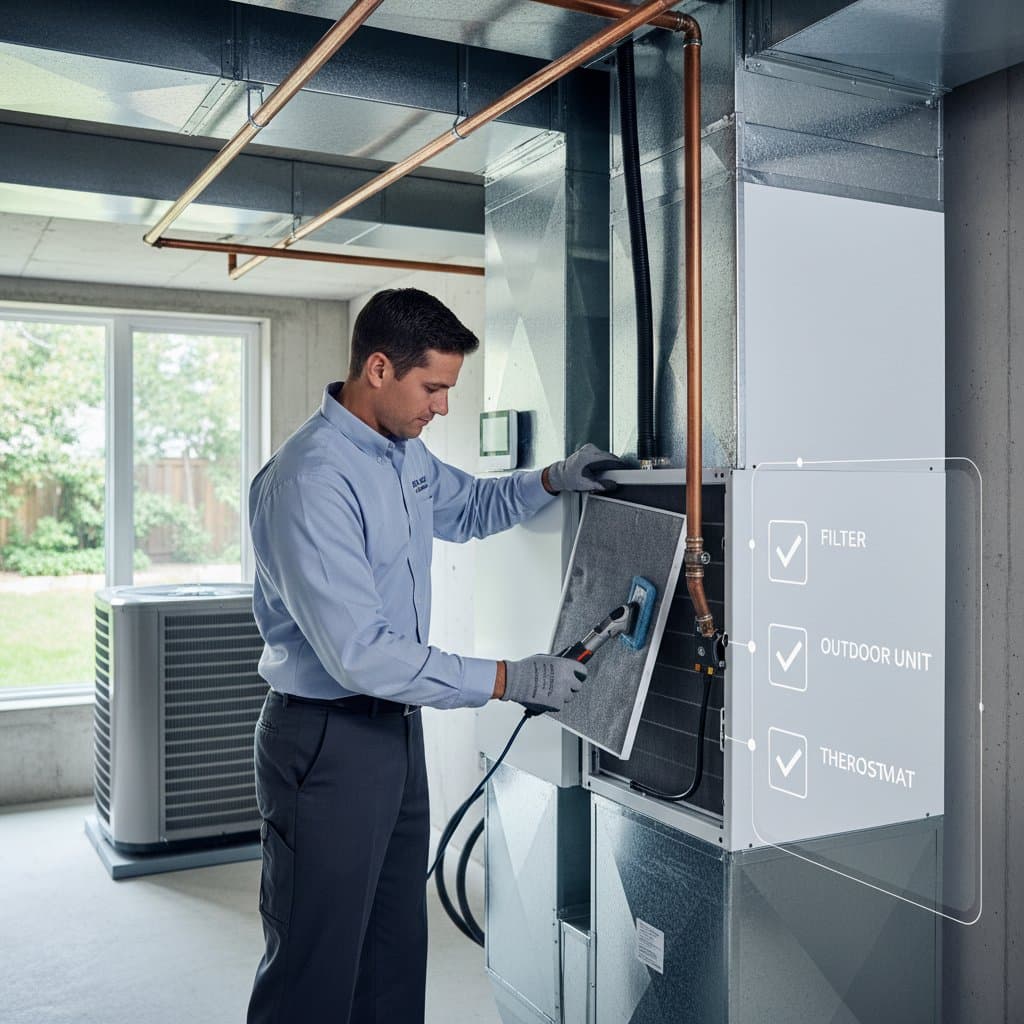The Pre-Season HVAC Tune-Up That Saves Big in 2025
Homeowners face unpredictable hot spells each year. These periods demand reliable performance from air conditioning systems. A pre-season HVAC tune-up prepares the equipment for peak demands, avoids expensive breakdowns, and controls energy expenses. Neglecting this maintenance often results in elevated cooling bills and urgent service calls during times of high technician demand.
This tune-up offers benefits beyond summer readiness. It prolongs equipment lifespan, enhances indoor air quality, and detects minor problems before they escalate into major repairs. As energy prices continue to increase, the investment in one maintenance visit yields rapid returns through improved efficiency.
Components of a Professional Tune-Up
Professional HVAC tune-ups examine both cooling and heating elements, given their shared air distribution network. Technicians conduct thorough inspections and adjustments. The process typically encompasses these key steps:
-
Cleaning the condenser coils
Accumulated dirt and debris impair heat dissipation, compelling the unit to operate with greater effort. Thorough cleaning restores optimal heat transfer and alleviates stress on the compressor, which can otherwise lead to premature failure. -
Checking refrigerant levels
Insufficient refrigerant may indicate leaks or incorrect charging. Technicians verify and adjust levels to promote effective cooling while preventing coil icing, which disrupts airflow and efficiency. -
Inspecting electrical connections
Frayed, loose, or corroded wiring risks erratic operation or electrical hazards. Secure tightening and comprehensive testing safeguard the system against interruptions and potential fires. -
Testing the thermostat
Inaccurate thermostats lead to unnecessary energy consumption. Professionals calibrate the device for precise temperature control, ensuring consistent comfort without excess runtime. -
Lubricating moving parts
Components such as motors, fans, and bearings require adequate lubrication to minimize friction and operational noise. This maintenance extends the durability of these parts, reducing long-term replacement needs. -
Checking the condensate drain
Obstructions in drain lines cause water accumulation and interior leaks. Clearing these pathways during the tune-up protects structural elements like flooring and walls from moisture damage. -
Inspecting ductwork and filters
Leaks in ducts and clogged filters hinder airflow, compromising efficiency and air purity. Technicians seal ducts and install fresh filters to enhance circulation and filtration immediately. -
Testing system performance
Following all adjustments, experts evaluate airflow rates, temperature drops across the coils, and total output. These metrics confirm the system operates at maximum efficiency, ready for seasonal loads.
Homeowners benefit from understanding these steps, as they highlight the comprehensive nature of professional service. Many overlook the interconnectedness of HVAC components, yet addressing them collectively maximizes system reliability.
Optimal Timing for Scheduling
Arrange the tune-up prior to the onset of intense cooling demands. This approach secures convenient appointment slots and standard service rates. Delaying until heat waves arrive often means extended wait times and premium pricing for urgent interventions.
For systems used continuously for heating and cooling, plan biannual maintenance. One visit precedes summer, and another anticipates winter. This schedule maintains steady performance and averts surprises throughout the year.
Consider regional climate patterns when timing appointments. In areas with early warm weather, schedule in late spring. Technicians recommend aligning with manufacturer guidelines, typically every six months for optimal results.
Frequent Issues Detected in Tune-Ups
Routine inspections reveal problems that could precipitate system downtime if ignored. Addressing them proactively saves significant repair expenses. Common discoveries include:
- Refrigerant leaks, which diminish cooling power and elevate energy demands as the system compensates.
- Burned-out capacitors, essential for initiating the compressor; failure here halts operation entirely.
- Clogged condensate lines, leading to overflows and interior flooding that damages building materials.
- Worn belts or bearings, generating excessive noise, vibration, and accelerated component wear.
- Dirty evaporator coils, prone to freezing, which restricts airflow and strains the entire unit.
Technicians document these findings with photos or reports for homeowner review. Early intervention on such issues prevents cascading failures, such as compressor burnout from overwork. Statistics from industry sources indicate that tune-ups reduce breakdown risks by up to 80 percent.
Indicators Requiring Immediate Professional Attention
Monitor your air conditioner for signs of distress. Difficulty in reaching set temperatures suggests underlying inefficiencies. Unusual noises, such as grinding or rattling, point to mechanical imbalances that demand prompt evaluation.
A musty odor from vents often signals mold growth in ducts or coils. Ice formation on the outdoor unit indicates refrigerant issues or restricted airflow. Frequent cycling, where the system turns on and off rapidly, wastes energy and stresses components.
Non-responsive thermostats or inconsistent cooling across rooms warrant expert diagnosis. These symptoms typically require tools and expertise beyond basic homeowner troubleshooting. Delaying service can transform minor fixes into comprehensive overhauls.
Strategies to Avoid Recurring Problems
After completing the tune-up, maintain detailed records of the service, including dates, observations, and replaced parts. This documentation aids in monitoring system health and validating warranty coverage during future claims.
Explore maintenance agreements from HVAC providers. These programs provide benefits like expedited appointments, reduced repair fees, and automated reminders. For households with demanding schedules, such plans ensure consistent upkeep without oversight.
For equipment exceeding ten years of age, inquire about modernization options. Upgrades to variable-speed compressors or programmable thermostats can lower energy use by 30 percent or more. Pairing these with the tune-up amplifies long-term savings and performance.
Implement simple daily habits to support the system. Adjust thermostat settings when away from home, and ensure outdoor units remain free of vegetation. These practices complement professional maintenance and extend intervals between services.
Safeguarding Your HVAC Asset
The HVAC system represents a substantial home investment, integral to daily comfort. Pre-season tune-ups deliver essential protection against wear, cost overruns, and disruptions. By prioritizing this care, homeowners secure reliable operation through the hottest periods.
Anticipate 2025's warmer trends with confidence. Early action translates to lower bills, superior air quality, and reduced stress. Treat tune-ups as essential home stewardship, scheduling them to sustain your system's peak condition year after year.





